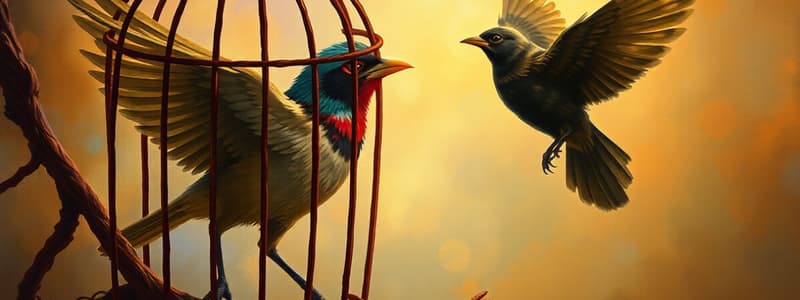Podcast
Questions and Answers
What does the imagery of the 'narrow cage' and 'bars of rage' primarily symbolize for the caged bird?
What does the imagery of the 'narrow cage' and 'bars of rage' primarily symbolize for the caged bird?
- The bird's longing for companionship with other caged birds.
- The bird's internal frustration and anger caused by confinement. (correct)
- The bird's physical limitations and inability to fly.
- The bird's acceptance of its fate and resignation to captivity.
The line 'the caged bird sings of freedom' suggests that despite its circumstances, the bird:
The line 'the caged bird sings of freedom' suggests that despite its circumstances, the bird:
- Believes that singing will magically break open the cage and release it.
- Has come to terms with its captivity and no longer desires freedom.
- Sings only to mock the free bird's ability to fly and enjoy the open sky.
- Maintains a deep, unwavering hope and yearning for liberation. (correct)
How does the poem contrast the perspectives and experiences of the free bird and the caged bird?
How does the poem contrast the perspectives and experiences of the free bird and the caged bird?
- The free bird is acutely aware of the caged bird's suffering and tries to help.
- The free bird embraces boundless opportunities, while the caged bird faces harsh limitations. (correct)
- Both birds experience a similar level of contentment and satisfaction in their lives.
- The free bird focuses on survival, while the caged bird contemplates philosophical ideas.
The phrase 'his shadow shouts on a nightmare scream' illustrates:
The phrase 'his shadow shouts on a nightmare scream' illustrates:
What is the significance of the caged bird's song being 'heard on the distant hill'?
What is the significance of the caged bird's song being 'heard on the distant hill'?
Flashcards
The Free Bird
The Free Bird
Represents boundless opportunities and choices.
The Caged Bird
The Caged Bird
Symbolizes oppression and lack of freedom.
The Caged Bird's Song
The Caged Bird's Song
The caged bird's only form of resistance and hope.
Longed-for Freedom
Longed-for Freedom
Signup and view all the flashcards
Juxtaposition
Juxtaposition
Signup and view all the flashcards
Study Notes
- The free bird joyfully rides the wind, drifting downstream until the current fades.
- It gracefully dips its wings in the sun's orange rays and boldly asserts its claim to the sky.
- Conversely, the caged bird walks within the confines of its narrow cage, rage blinding its vision.
- Its wings are clipped and feet bound, leading it to express itself through song.
- The caged bird sings with a trembling voice of the unknown, yet yearned-for, things.
- Its melody carries to distant hills, communicating a yearning for freedom.
- The free bird contemplates the gentle trade winds whispering through the trees.
- It also considers the plentiful worms awaiting it on a bright, dewy lawn, fully claiming ownership of the sky.
- The caged bird exists amidst shattered dreams, its shadow screaming in a nightmarish state.
- Its physical restrictions compel it to sing.
- The caged bird’s song, filled with fear and longing, echoes in the distance, symbolizing a desire for liberty.
Studying That Suits You
Use AI to generate personalized quizzes and flashcards to suit your learning preferences.




